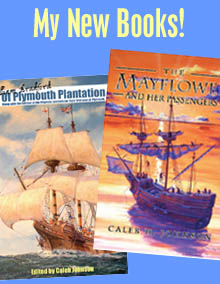| Home |
| Introduction |
| Mayflower Passenger List |
| Pilgrim History |
| Mayflower Genealogy |
| Primary Sources and Books |
| Societies and Museums |
| Bookstore and Gift Shop |
The Mayflower's Crew
The Mayflower likely carried a crew of about 25 or 30. Unfortunately there was no list of the names of the crewmembers recorded, so only a few names are actually known.MASTER:
Christopher Jones
Christopher Jones was originally from Harwich, Essex, England, born about 1570,
the son of Christopher and Sybil Jones. One of his first ships was the
Marie Fortune, which he received from his father after his death. In
1593 he married Sarah Twitt in his hometown of Harwich, but she died in 1603.
He remarried to Josian (Thompson) Grey, daughter of Thomas Thompson and widow of
Thomas Gray. Christopher Jones was master of the ship Josian, named
after his wife. About 1609 he bought a quarter share in the 180-ton
Mayflower and moved his family to Rotherhithe, near London, shortly
thereafter. He used the Mayflower primarily in the wine trade,
frequenting the French ports of Bordeaux and La Rochelle. He brought the
Pilgrims to Plymouth on the Mayflower in 1620, and returned to his old
profession of transporting cargo to and from France. He died a couple
years later, in March 1622, and is buried at St. Mary's Church in Rotherhithe.
MASTER'S MATE: John Clark
John Clark was perhaps the John Clark baptized on 26 March 1575 in Rotherhithe,
Surrey, England. He first went to Jamestown, Virginia in March 1610 as a
ship's pilot. There, at Point Comfort, he was captured by the Spanish in
June 1611. He was taken captive to Havana, Cuba, where he was
interrogated, and then sent to Seville, Spain, and then on to Madrid in 1613.
He was held as a prisoner until he was exchanged for a Spanish prisoner held by
the English in 1616. He immediately went back to his occupation as a
ship's pilot, and took a shipment of cattle to Jamestown, Virginia in 1619 under
some-time pirate Thomas Jones. In 1620, he was hired to be the master's
mate and pilot of the Mayflower, on its intended voyage to Northern
Virginia. While the Pilgrims were exploring Cape Cod and Plymouth Harbor,
the shallop was caught in a storm and Clark brought them safely ashore at an
Island, which is to this day known as Clark's Island. After returning,
John Clark decided to settle in Virginia himself. He went to Jamestown in
1623 on the ship Providence, with the intention of settling there, but
died not too long after his arrival.
MASTER'S MATE: Robert Coppin
Robert Coppin probably came from Harwich. He held a share of Virginia
Company stock in 1609, and had been to the Massachusetts coastline on a previous
trip, although it is not known exactly when. He recalled that the last
time he was there, some of the Indians stole a harpoon from their ship, so they
nicknamed the area Thievish Harbor.
SHIP SURGEON: Giles Heale
Giles Heale had become a freeman in London on 3 April 1619, and had served out
his barber surgeon's apprenticeship with Edward Blaney. His voyage on the
Mayflower must have been one of his first. On February 10, Mayflower
passenger Isaac Allerton gave him a book written by Henry Ainsworth. And
on February 21, he witnessed the will of William Mullins. After he
returned, he was a barber surgeon practicing on Drury Lane, St. Giles in the
Field, London. He died in 1653, apparently having no surviving children:
he willed everything to his brother Henry and wife Mary.
SHIP'S COOPER: John Alden
John Alden was born about 1599, most likely in Harwich, Essex, England, related
by marriage to Christopher Jones and also to Mayflower passenger Richard
Gardinar. Alden was hired at Southampton to be the Mayflower's cooper, the
individual responsible for the construction, repair and maintenance of the
ship's barrels. Alden was given the choice to stay at Plymouth, or return
to England. He chose to stay, and his young blood and carpentry skills
were much welcomed by the colonists. He married a year or so later to
Priscilla Mullins, and raised his family at Plymouth and later helped found the
town of Duxbury.
OTHER CREWMEMBERS
The above crewmembers are the only ones that can be conclusively identified.
There are a couple of "mystery men" that were likely to have been crewmembers.
The first is a "Master Leaver", mentioned on one occasion in the Pilgrims'
journal "Mourt's Relation". There is a Thomas Lever listed just a
few names before Robert Coppin on the list of Virginia Company investors made in
1609. In another place in "Mourt's Relation", mention is made of a "Master
Williamson", and a "Master Williamson" is mentioned in the 1621 will of William
Mullins as well. Some have suggested this might be a pseudonym for William
Brewster, who was still a fugitive from English authorities. Others have
suggested that perhaps Master Williamson was a member of the Mayflower's
crew. In 1929, Charles Banks noted there was a will for an Andrew
Williamson, seaman, in the Prerogative Court of Canterbury. In 1750, John
Phillips made a deposition to the Superior Court of Massachusetts, indicating
that he was told by his father that his ancestor John or Thomas Parker was a
mate on Mayflower. However, 130 years is a long time for accurate
oral tradition to survive. The Pilgrims also hired a couple of seaman for
themselves, to stay in New England for a year:
William Trevore,
Mr. Ely, and perhaps
Richard Gardinar.
